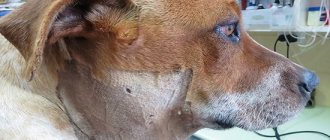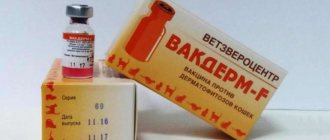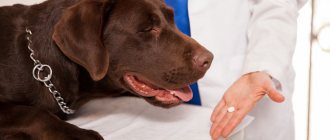An abscess in a cat is any infected area on the body of your mustachioed pet, inside of which pus has accumulated. In itself, this pathology does not pose a big threat if you react to it in time. In the same situation, if you miss time, the consequences can be unpleasant and much more global than a festering wound. Let's consider how an animal could get an abscess, what types of this disease are most often observed in cats, and how to help your pet cope with the disease.
Abscess in a cat
Types of abscess and photos
Today, the most common types of abscesses that occur in animals are:
- Suppuration located inside the oral cavity.
- A combat abscess, in which wounds can be located on any part of the animal’s body.
- Abscess of the paraanal glands is suppuration of the glands that help animal feces move along the extreme segment of the digestive tract.
Let's look at the types of diseases listed above in the table below.
Table 1. Types of abscesses in cats
| View | Image | Characteristic |
| Dental abscess | Dental abscess or oral abscess | The occurrence of a dental abscess most often occurs in a situation in which you, that is, the owner of the animal, did not care about the condition of his oral cavity. As a result of the lack of regular cleanings and the build-up of plaque, periodontal disease forms, which gradually leads to the development of a serious infection, due to which the cat develops ulcers on the gums. This condition seriously impairs the quality of life, because your cat:
|
| "Combat" abscess | Battle abscess that has spread to the cat's cheek and neck | The name of this type of abscess refers us not so much to the location of the sore, but to the cause of its occurrence. So, the cause is usually fights with other cats or, for example, dogs, as a result of which your pet’s opponent injures him with his teeth. As you know, the oral cavity of every animal contains a huge number of bacteria. When a puncture wound from a bite occurs, these bacteria penetrate your cat's skin. Since the healing ability of the animal body manifests itself much faster than that of humans, the torn epithelium in them quickly heals in almost one hundred percent of cases, and the infection remaining after the bite is isolated under the skin. Provided that your cat's immunity is strong, she will be killed, otherwise suppuration will begin |
| Abscess of the paraanal glands | Anal gland abscess in a cat | The paraanal glands are located in the anus area of pets. The secretion they produce is designed to soften the pet’s feces and facilitate their rapid and effective exit. However, in some cases, the glands begin to produce excess secretion and become clogged. If in the norm of things the release of this substance should be carried out during the passage and pressure of feces, then with the presented pathology this does not happen. Due to excess and stagnation of secretion, the glands begin to become inflamed. The causes of this disease usually lie in:
|
Please note: no matter what type of abscess your cat is affected with, along with this disease he has a high risk of contracting feline AIDS.
Feline immunodeficiency (feline AIDS): symptoms
Among other things, as we mentioned above, the animal’s body will weaken so much that many other infections and diseases can freely develop inside your pet’s body. Unfortunately, it is very difficult to treat a whole “bouquet” of diseases, and often the work of veterinarians yields nothing, and the exhausted animal dies.
Signs of an abscess (abscess, abscess) in cats
So that you can react in time and help your pet, you need to understand how the abscess that affects his body manifests itself.
How to identify an abscess in a cat?
Let's look at the main list of signs, if detected, you can identify an abscess and contact a veterinarian in time.
- The main and, perhaps, the most accurate sign in which you can clearly understand that you have an abscess is the detection of infiltration on your pet’s body. An infiltrate is a tubercle, inside of which there is clearly some kind of liquid, which is soft to the touch. The skin at the site of infiltration formation may change color, or may retain its original shade;
- The second sign of an abscess in an animal is pain. It can be localized:
- At the site of immediate suppuration.
- Near the infected area.
In other words, your cat will react violently and dissatisfiedly not only to pressure and touch in the area of the tubercle, but also on the surface of the body adjacent to the lesion. Even if you try to pet him, the sensation will be unpleasant, and the cat will show it.
- disruption of the normal functioning of the part affected by the abscess is another sign. We mean that due to pain, the animal will try not to touch the location of the infiltrate. So, for example, it may manifest itself as follows:
- If the suppuration is located in the oral cavity, the animal may completely refuse food and will only drink water.
- Provided that the abscess affects the paw, the cat will stop stepping on it, or will walk with a limp.
- The fourth sign of abscess formation is baldness of the place in which it is located. Provided that your cat has fur (there are also hairless cats), you will notice the abscess even from afar, since in the place where it will be located you will find:
- Bald spot.
- Puncture wound.
- Scabs.
Baldness in the area of the abscess
- Another unambiguous sign of the presence of an abscess in your pet is the discharge of pus with blood from the wound, in the place where your beloved cat was bitten by the enemy;
- provided that the paraanal gland is affected by the abscess, you will see a large, most likely red, lump next to the animal’s anus;
- a terribly unpleasant odor will emanate from the site of suppuration, characteristic of rotting wounds;
- the presence of such a serious inflammatory process can also affect the behavior of the animal and its general well-being. So, in almost one hundred percent of cases the cat will:
- Lethargic.
- Experience a fever.
- Refuse food.
With an abscess, the animal becomes inactive
As you can see, there are quite a few symptoms of an abscess. Only the most inattentive owner will not notice such a serious disease in his animal, because it causes discomfort and pain to the cat. Remember that animals are creatures with a nervous system. They feel pain just like humans, and are capable of experiencing negative emotions just like us.
You cannot delay treatment, because your pet feels pain, both on a mental and physical level
Signs of suppuration development
In cats, purulent abscess is a common occurrence. It is important for the pet owner to know all the symptoms of the pathology in order to respond promptly and correctly to its appearance.
An abscess goes through 5 stages of development:
- Redness of a small area of skin . The pathological process can only be identified with a detailed examination. The animal does not experience any discomfort when the disease occurs.
- Edema . As the infection spreads, a cavity forms under the skin, which gradually fills with pus and swells.
. The purulent capsule is completely filled with contents, increases in size, and becomes convex.
Fluctuation- Baldness . Hair begins to fall out on the affected areas of the skin and they become completely bare. During this period, the owner can easily determine the presence of pathology.
- Tissue necrosis . Ideally, if the animal has a strong immune system, if there is severe suppuration, the purulent capsule should rupture, and the contents will come out to the surface of the skin. In weakened animals, the inflammatory process continues and healthy cells become infected.
Causes of abscess in cats
As we said earlier, the reasons for the development of an abscess are:
- damage;
- infection.
Infected with this pathology can be:
- epithelium;
- paraanal glands;
- oral cavity.
Most often, a cat’s abscess is a skin abscess, that is, a combat abscess, which developed as a result of receiving a bite in a fight with an enemy. As for harmful bacteria, which become infectious agents in each of the described cases, the following are most often found in pus:
- streptococcus;
- staphylococcus, etc.
It is during the reproduction of harmful organisms included in the class of pyogenic that a liquid substance is formed in the wound
However, it is not always necessary to damage the skin for the birth of an abscess. The infection will thrive in those tissues of the cat's body that have cavities, for example, in the gums surrounding the animal's teeth. Such an abscess forms when an infection enters your pet’s body and he is unable to fight it off on his own.
What is the danger?
If the formation is not treated properly, it can result in sepsis for the pet.
If, after opening, the cat’s boil is not treated in time, then unpleasant consequences are possible. An abscess is often complicated by the following disorders:
- proliferation of affected areas and formation of phlegmon with pus;
- tissue death;
- blood infection;
- sepsis;
- death of a cat.
Complications caused by an abscess
The development of an abscess, as we have already mentioned, has a direct impact not only on the occurrence of pain and the appearance of pus in the infected area, but also worsens the overall well-being of the pet. Among other things, this pathology is also capable of creating favorable conditions for the occurrence of other diseases and the progression of infection.
What complications can occur with an abscess in cats?
So, provided that you did not make a decision on timely treatment of the cat’s abscess or discovered the abscess too late, these consequences and complications can complicate the life of your pet, and yours along with it.
Thus, abscesses are characterized by pain. A constant feeling of pain seriously affects the animal’s psyche, causing:
- groundless aggression;
- nervous tension;
- sudden weight loss;
- attempts to tear objects;
- going to the toilet in a variety of places, for example, on the sofa or the owner’s bed.
Groundless aggression
Another dangerous complication can occur like this: the infection from the abscess will spread into the tissue and infect such important elements of the cat’s body as:
- ears;
- joints, etc.
This can also happen when the wound is located on the very surface of the skin, or is far from the ears
Cats infected with a combat abscess are most susceptible to such terrible diseases as feline AIDS, etc.
Infection from an oral abscess can spread to the brain. In this case, the animal will begin to behave inappropriately and, most likely, will die in agony.
As you can see, curing your pet quickly is your main task. Adopting a cat means not only having a furry friend that you can hug and pet, but also acquiring a huge responsibility towards him. This responsibility includes feeding a quality diet, constant attention, regular bathing and grooming, and timely and regular veterinary visits.
If you are not ready to spend time and money on maintaining and treating a cat, it is better not to adopt it in the first place.
You can also think that the larger the abscess, the more pus and blood will be released from it, which will stain the furniture, floors, and walls that the animal touches. Take pity on him and yourself and immediately run to the doctor.
Anal gland infection
This gland secretes a secret that cats use to mark territory, attract females and scare enemies. It is located in the anus and in a healthy animal is cleared during the act of defecation.
In some cat breeds, the gland canal becomes blocked for various reasons. If it is not cleaned in time, pathogenic bacteria will cause an abscess, and after it opens, a fistula will form. This is extremely dangerous and the pet may die. In this case, treatment should only be carried out by a specialist. For some breeds, the veterinarian recommends cleaning the anal glands as a preventative measure.
Risk factors
Many cat owners live side by side with their pets for many years, but never observe the development of an abscess in them, while others, on the contrary, are constantly forced to treat this infection. Let's figure out what risk factors contribute to the occurrence of the desired disease in a particular cat.
The very first factor due to which your pet can be classified as a risk group is the free range of the cat. At their core, cats are domestic animals, not suited for life on the street, no matter what anyone says. Provided that you let your cat, especially an uncastrated one, out for a walk unattended, that is, not on a harness or leash, without your presence, be prepared for the fact that sooner or later they will run into an aggressive brother or an angry dog who in battle they will certainly inflict wounds on your pet. These same wounds will then become the reason for the formation of suppuration.
The life of free-ranging cats always ends badly, even if you think they need walks. Including many domestic cats walking on their own die from abscesses or lose vital organs
The best prevention aimed at reducing harm from this risk factor is depriving the animal of going outside. If you think that a cat should definitely go for a walk and this is done for the sake of its health, go to the end in the matter of its safety: go for a walk with the animal yourself, having first put a harness and leash on it.
The second risk factor, which has a certain impact on both cats walking on the street and those living at home with other animals, is being male. As you know, cats are more pugnacious than cats simply by nature, since they defend their territory at the level of instincts. Even in an apartment, if the cat thinks that someone is encroaching on his bowl, bed, or tray, a fight can break out, which will result in bites and the formation of infiltrates.
Cats show their character more aggressively
The third risk factor is temporary. So, when you bring a new animal into your home (whether a cat or a cat), be prepared for the fact that, regardless of gender, your pets will fight at first. In this way, both will demonstrate their strength before getting along peacefully and realizing that they share the territory of your home, whether they like it or not. However, it is best to stop these fights so as not to lead to illness. For this you can use:
- spray bottle with cold water;
- stern voice;
- spanking (namely spanking, not beating) with a rolled up newspaper.
The young age of the pet (up to about 7 years) is another risk factor. Young animals can fight even when they love each other. In fact, the fight in this case will be a game, but the bites will remain real. To protect mustachioed pets from getting hurt, try to redirect such games into a more peaceful direction, and play with them at the same time yourself, for example, using:
- medium sized balls;
- laces with a toy at the end;
- delicious treats, etc.
Even during harmless games, animals can injure each other.
Cats that have previously had an abscess may get it again, provided that the last wound, which apparently healed, did not heal completely, or their body did not, as you thought, cope with the infection on its own. These pets have a particularly high risk of spreading the infection.
Cats whose owners do not take care of their oral health are also at risk. Tartar must be cleaned if you want the animal to live long and be able to feed on its own. This service is provided in veterinary clinics. Believe me, this procedure is necessary for your cat, and for those who argue that street cats, for example, do not need cleaning, because nature intended it that way, answer that these animals are the fruit of selection work, and were not originally intended by nature. This means that all these speculations do not apply to them.
Tartar in a cat
Inflammation of the paraanal glands in a cat should be expected by those owners who do not monitor the animal’s motor activity and feed it the wrong food. In rare cases, the development of such an unpleasant disease can occur due to breed predisposition.
Prevention of the development of purulent formations
Cat owners should try to prevent any disease in their pets. Preventive measures are the best remedy for the development of an abscess.
Necessary activities:
- castration;
- limiting walks on the street and contact with yard animals;
- vaccination according to schedule;
examination and sanitation of the oral cavity, brushing teeth twice a week;- exclusion of small bones and rough foods from the diet;
- regular inspection, identification of skin damage, their timely disinfection and treatment;
- sterilization of instruments during medical procedures at home;
- treatment for fleas, ticks, lice;
- maintaining sanitation and hygiene.
As soon as a kitten gets into the house, it needs to create all the necessary conditions for proper development, provide age-appropriate food, and provide timely veterinary care.
Diagnosis of an abscess
One of the main tasks of cat owners is timely diagnosis of the condition of their pets, detection of various pathologies, such as an abscess. Remember, animals cannot speak, so they will not be able to explain to you what hurts them and how much.
All responsibility for the cat's health lies with you.
We have already said what signs an abscess can be identified by, but let’s once again briefly refresh our memory about what we were talking about. So, an abscess has the following characteristics:
- looks like a dense tubercle;
- soft to the touch;
- hot at the site of infection;
- yellow pus mixed with blood oozes from it;
- the cat demonstrates that it is in pain when you touch the infected area or area near it;
- an unpleasant odor emanates from the wound.
Unfortunately, hair at the site of suppuration does not always fall out, so the first thing cat owners should pay attention to is a change in its general condition, namely:
- lethargy;
- fever;
- lack of appetite;
- even aggression is possible;
- inappropriate behavior, for example, going to the toilet in the wrong place.
Lack of appetite
Provided that the condition of your animal has really changed, you should carefully examine those places where cats prefer to attack the enemy, namely:
- paws;
- tail;
- head;
- neck.
These are the points that animals consider weak, and this is where their relatives attack them. However, if your animal was bitten by a small dog or a particularly irritated cat, the abscess may be located on any other part of the body.
You should also monitor your cat's response to pain. Depending on the location of the abscess, she will try to protect the affected part of the body, that is:
- do not step on the sore paw;
- do not eat if your mouth is infected;
- do not allow herself to be stroked for fear that you will touch a place that is infected, because the pain of an abscess is very difficult to bear.
To save itself from pain, a cat may not change position all day and even bite you to keep you from coming closer.
Going to the vet
If you suspect an abscess, you should not try to squeeze the pus or cauterize the wound with alcohol (both are very painful, have mercy on your animal), but should quickly pull yourself together and seek help from a reputable veterinarian.
An experienced doctor, even if the abscess is hidden behind thick hair, will examine the hairline and find dull areas on it, behind which, most likely, an abscess will be found.
Then careful palpation will be performed to detect the infiltrate. In this case, you will most likely have to hold the animal, otherwise it will scratch the doctor.
If a tubercle is detected, the fur at the site of suppuration is shaved off. Often traces of a wound are found on bare skin, which was the reason for the development of suppuration. In some cases, the wool is also clipped in other places, and new ones are discovered:
- wounds;
- abscesses.
In some cases, they are even applied by different teeth.
To determine the specific disease, your veterinarian will need to examine your friend.
Most often, experienced veterinarians diagnose abscesses solely through external examination and light palpation, however, in some situations it is necessary to:
- bacterial culture analysis;
- microscopic analysis of the substrate flowing from the wound.
Provided that you are one of those owners who monitor their animal, most likely you will be able to detect the disease in the early stages and go to see an animal doctor. Unfortunately, in this case, the doctor will not be able to diagnose you immediately; he will need to:
- run a couple of tests;
- carry out a medical examination.
Please note that the cost of such tests is extremely low, and waiting for a painful abscess to form in an animal in order to save money is not only cruel, but also extremely useless.
Treatment of abscess (abscess, abscess) in cats
Of course, today many owners of cats with an abscess have turned to veterinarians, so today there are the most effective schemes for eliminating the desired pathology. Exactly how your pet will be treated will depend on what stage of development the disease is in when presented.
How are abscesses treated in cats?
First stage
In the early stages, treatment with the following drugs is used:
- penicillin antibiotics to eliminate harmful microorganisms;
- novocaine to eliminate pain;
- streptocides to fight infection.
All of the above drugs are taken orally, while external treatment is also practiced, namely:
- lightening with a Sollux infrared lamp to resolve inflammation and relieve pain;
- ultraviolet light to dry the wound;
- heating pad and warming compresses to eliminate pain.
All of the above procedures allow you to eliminate the abscess quickly and with minimal losses to the cat’s health.
Second stage (formed abscess)
Treatment of an abscess that has already formed is carried out through invasive intervention, since the main task of doctors at this stage is to remove the purulent substrate from the wound. For this:
- the animal's fur is shaved off at the site of the inflamed area and around it;
- the animal's skin is disinfected;
- the animal is put into a state of anesthesia;
- a long incision is made at the site of inflammation;
- the wound is opened and all accumulated pus is removed.
it is very important to leave the wound open and dry, because the pus that is not completely removed will then lead to the re-formation of an abscess.
A cat who has received this treatment is prescribed:
- washing the wound with antiseptics (not alcohol, otherwise the tissue will be burned);
- taking antibiotics.
Treatment of the wound
Fortunately, due to the ability of the animal body to recover very quickly, which we previously mentioned, after cleaning the wound, the animal recovers almost within a few days.
Third stage (advanced abscess)
Provided that for some reason you have started the disease, and the abscess has spread deeply and grown to a substantial size, doctors, just as in the second stage, will open the wound and clean it of pus. However, in this case, you will have to sew it up, not just like that, but leaving the latex tubes sewn in so that the cleaned cavity can be drained from the newly formed pus.
Drainage tube
Vishnevsky ointment will need to be applied to the stitched wound, and after some time the wound will be cleansed through sewn-in tubes by injecting antiseptic drugs into them.
It also happens that due to the presence of an abscess in an animal, a necrotic process has begun in the tissues located next to it. In this case, they will need to be removed and processed:
- hydrogen peroxide;
- potassium permanganate;
- hypertonic solution.
Then the location of the former abscess should be sprinkled with antiseptic powders, and drainage with a hypertonic solution should be installed.
Diagnostic procedures
An abscess can appear in pets after sterilization or under the influence of other negative factors. When the first symptoms develop, you should contact a veterinarian who will help you properly treat the disease without causing complications. Before treatment, a comprehensive diagnosis is carried out to determine the source of the abscess, its type and severity. The cat needs to undergo the following diagnostic procedures:
- laboratory testing to determine the causative agent of the disease;
- antibiotic sensitivity test.
During differential diagnosis, the presence of a hematoma in the animal should be excluded.
No less important is differential diagnosis, which helps to distinguish an abscess in a cat from pathologies such as:
- cystic formation;
- benign or malignant tumor;
- granuloma;
- hematoma;
- lymphoextravasate.
How to independently help an animal in the initial stages of the disease?
Provided that you have discovered a developing abscess in your pet, but cannot take him to the veterinarian in the next few days, you can help him, provided that you have at home, for example:
- healing mineral mud;
- veterinary or human ointment "Levomekol" or other antimicrobial agents, etc.
So, at the initial stage of suppuration, they heal well if they are treated with antibiotic ointments in a timely manner. “Levomekol” is the most affordable of them all; in a veterinary store, a fairly large amount of the product can be bought for about two hundred rubles.
In addition, mineral mud of natural origin will perfectly dry and eliminate pus. When heated, apply it to the animal’s abscess, and it will heal, if, of course, it has not yet begun to progress and go deeper into the tissue. The mud needs to be heated to approximately 42-45 °C.
Under no circumstances should you open an abscess yourself; entrust this work to a veterinarian.
However, even if the abscess has progressed, and there is still no opportunity to see a doctor due to objective reasons, try to give your patient antibiotics from one of the following groups:
- penicillin;
- cephalosporin;
- clindamycin.
In addition, be sure to do the following:
- give the animal an anesthetic (provided that the drug is calculated according to the instructions, based on the pet’s weight);
- Use an Elizabethan cone collar or other homemade protection to prevent the animal from licking and biting itself.
Until the abscess matures, warm it with heating pads or warming compresses. However, keep in mind that if the animal has a fever and you feel its temperature is elevated, you should not use them, as this will only worsen its condition.
After the wound has been cleared of pus by the doctor, the responsibility for continuing treatment will fall on you. It is assumed that you will have to:
- wash the wound;
- change bandages.
Do your best and your pet will remain healthy, no matter what stage the abscess is at.
Unfortunately, in the later stages, this disease is difficult to cure on your own. In addition, if we are talking about the occurrence of this pathology in the anal glands or in the mouth, it is impossible to do it yourself.
Let's sum it up
An abscess in a cat is an unpleasant disease characterized by the occurrence of suppuration:
- under the skin;
- in the gums;
- in the animal's anal glands.
Curing this disease can be difficult, especially if it is complicated by other pathologies, so the best solution for you is to isolate your pet from the street, and therefore from other aggressive animals. If you are still a fan of street walking, and are not at all afraid for the health of your pet, at least castrate/sterilize him. This will seriously reduce the desire to enter into conflict and fight for territory with other cats.
Take care of your animal, because you have taken responsibility over it
If fights occur between the old and new residents of your apartment, gradually introduce the pets to each other, offering them common leisure time in the form of sharing food and playing with you.
We would also like to draw your attention to the fact that an abscess in a cat can also develop in organs and other internal segments of the body. In such a situation, you are unlikely to be able to diagnose it yourself; you must promptly contact a veterinarian for a correct diagnosis and timely treatment of the disease.
Treatment
- In a critical situation, the surgeon, under local anesthesia, shaves the hair around the abscess and opens it: removes pus, dirt, splinters or other foreign bodies.
The specialist disinfects the resulting cavity with antibacterial drugs, inserts a tube to drain the fluid and applies sutures.
Drainage prevents the formation of a recurrent abscess. After 3-5 days it can be removed, and the mark from it will quickly heal.
- At the medicinal stage of treatment, the doctor prescribes: antibiotics in the form of injections, painkillers, anti-inflammatory drugs, dressings using external ointment chloramphenicol or streptomycin. This therapy can be done at home.











